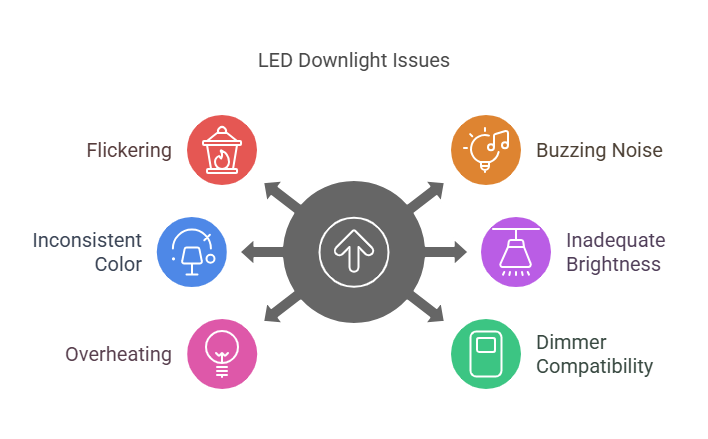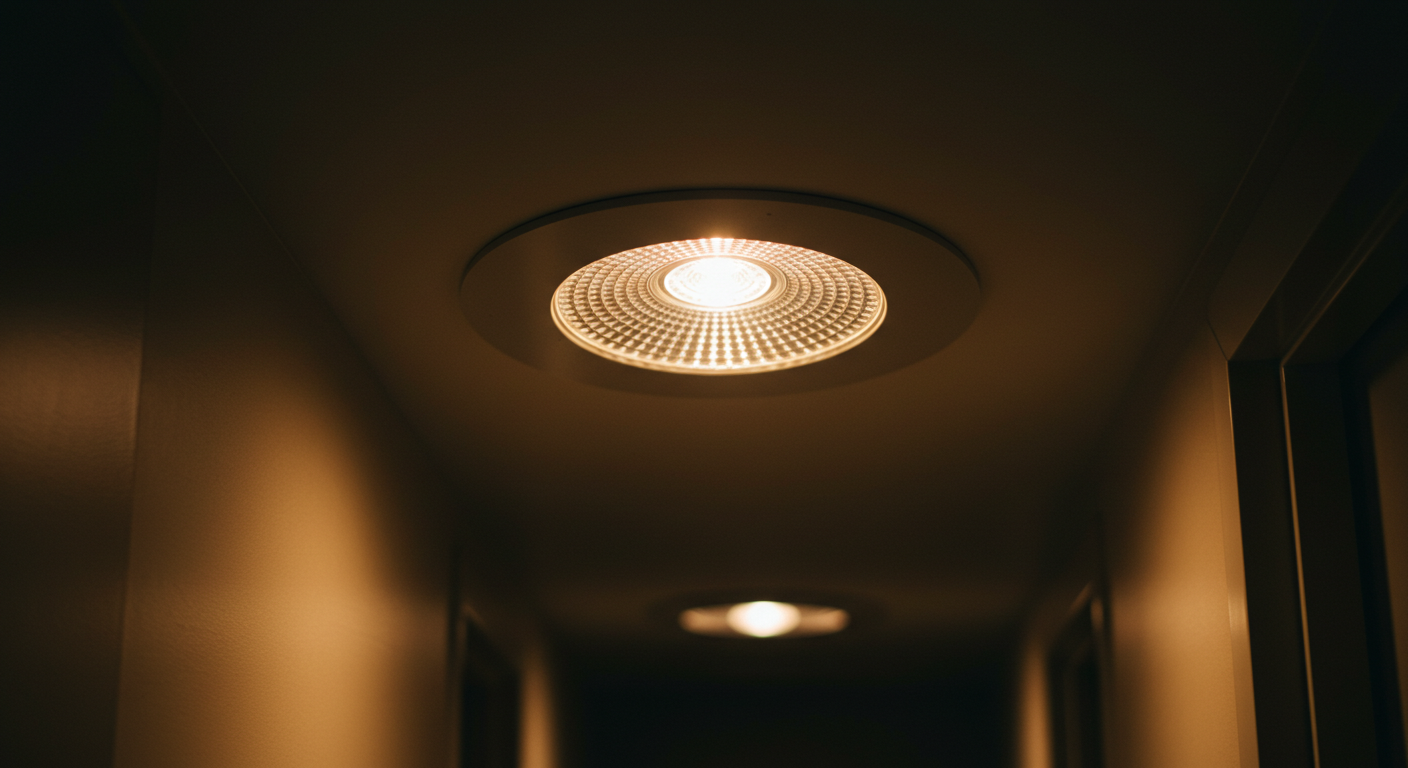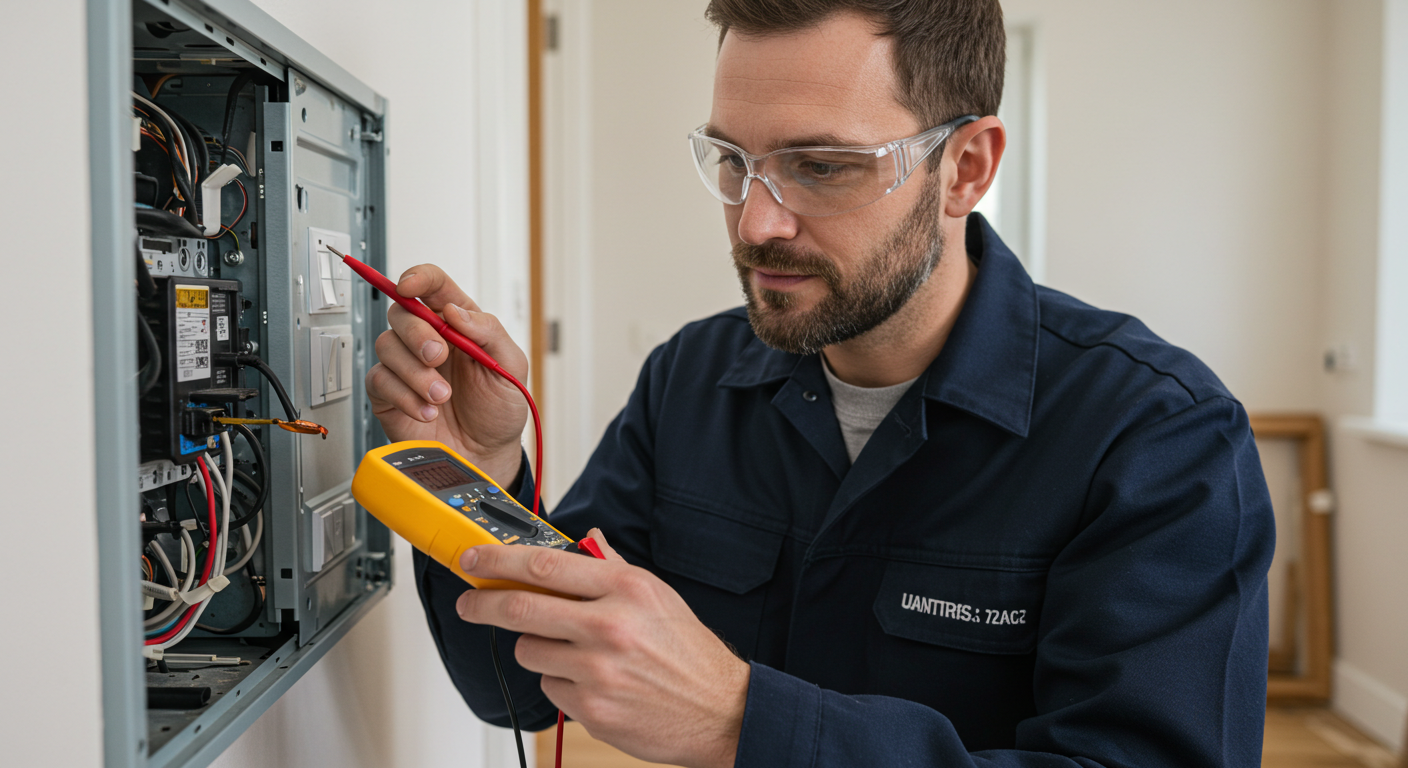Looking to modernise your home while reducing energy costs? LED downlights are an excellent solution, offering both efficiency and longevity.
However, encountering issues like flickering or unexpected dimming can be frustrating. Understanding and addressing these common problems ensures your lighting system functions flawlessly, providing consistent, high-quality illumination.
🗹 WLED downlights, while efficient, can present several common issues:

- Flickering
One of the most common problems with LED downlights is flickering. Several factors, including power supply issues, incompatible dimmer switches, or poor-quality LEDs, can cause flickering. It can be particularly annoying and may even cause eye strain over time.
- Buzzing or Humming Noise
Another common issue is a buzzing or humming noise, often caused by electrical interference or incompatibility with dimmer switches. This noise can be distracting and detract from the overall comfort of your home.
- Inconsistent Color Temperature
LED downlights sometimes produce inconsistent colour temperatures, leading to an uneven lighting environment. This can be particularly problematic in areas where uniform lighting is essential, such as kitchens or living rooms.
- Inadequate Brightness
Some homeowners find that their LED downlights do not provide adequate brightness. This issue can occur if you use dim bulbs or if there aren’t enough lights to fully light an ample space. Using bulbs that are not bright enough can cause the problem.
- Overheating
LEDs produce less heat than regular bulbs. However, they can still overheat. This can happen if they are not installed correctly or if they do not have enough ventilation. Overheating can reduce the lifespan of the bulbs and pose a safety risk.
- Compatibility with Dimmer Switches
Not all LED downlights are compatible with dimmer switches, leading to issues such as flickering or buzzing when dimmed. Ensuring compatibility is crucial for a smooth and trouble-free dimming experience.

🗹 Troubleshooting and Solutions for LED Downlight Issues
Addressing these issues involves targeted solutions:
Flickering
- Check the Power Supply: Ensure your power supply is stable and sufficient for LED downlights. Unstable or fluctuating power can cause flickering.
- Use Compatible Dimmers: Ensure your dimmer switch is compatible with LED lights. Not all dimmers work well with LEDs, leading to flickering issues.
- Invest in Quality LEDs: Sometimes, flickering can result from poor-quality LEDs. Investing in higher-quality bulbs can mitigate this issue.
Buzzing or Humming Noise
- Ensure Correct Voltage: Verify that your LED lights receive the correct voltage. Mismatched voltage can cause buzzing or humming.
- Replace Incompatible Dimmers: If the noise persists, consider replacing your dimmer switch with one designed for LED compatibility.
Inconsistent Color Temperature
- Use Same Manufacturer: Purchase all your LED bulbs from the same manufacturer to ensure consistent colour temperature.
- Check Colour Temperature Ratings: Pay attention to the colour temperature ratings (measured in Kelvins) to maintain uniform lighting.
Inadequate Brightness
- Select Higher Lumen Bulbs: Choose bulbs with higher lumen output to achieve the desired brightness.
- Add More Fixtures: If one fixture isn’t enough, consider adding more to evenly distribute light throughout the space.
Overheating
- Ensure Proper Ventilation: Install LED downlights in fixtures that allow adequate ventilation to prevent overheating.
- Use Rated Fixtures: Only use LED bulbs in fixtures rated for LEDs to avoid overheating issues.
Compatibility with Dimmer Switches
- Check Compatibility: Always check the compatibility of your dimmer switch with your LED downlights. Look for dimmers designed explicitly for LED use.
- Replace Incompatible Dimmers: If your current dimmer causes problems, replace it with an LED-compatible model.

🗹 Advanced Solutions and Tips
Smart LED Downlights
Consider upgrading to smart LED downlights that offer features like remote control, scheduling, and integration with smart home systems, providing greater convenience and customisation.
Energy Efficiency Tips
Maximise energy savings by pairing LED downlights with natural light sources and installing dimmer switches to adjust brightness as needed.
Maintaining Your LED Downlights
Regular maintenance extends the lifespan of your LEDs. Clean fixtures to remove dust and debris, inspect for signs of wear or damage, and replace bulbs when necessary.
🗹 When to Call an Electrician?
While some LED downlight problems can be fixed with DIY solutions, you should contact a licensed electrician when:
- The light fittings or wiring are damaged
- Flickering continues even after replacing bulbs and dimmers
- You smell burning or see signs of overheating
- Circuit breakers trip frequently when lights are turned on
🗹 Keep Your LED Downlights in Perfect Condition
You can enhance their performance and longevity by proactively troubleshooting and maintaining your LED downlights. Addressing common issues like flickering, buzzing, and overheating ensures you reap the full benefits of LED lighting.
Need professional assistance with your LED downlights? Contact Olympic Electrical today for expert solutions and services.
🗹 FAQs
1. Why do my new LED downlights flicker?
It’s often due to incompatible dimmers or power fluctuations. Check both before replacing the lights.
2. Can LED downlights be installed in older homes?
Yes, but it may require updated wiring or fixtures. Consult a licensed electrician for safety.
3. Are LED downlights safe to leave on all night?
Yes, they use minimal energy and produce less heat, making them safer than traditional bulbs.
